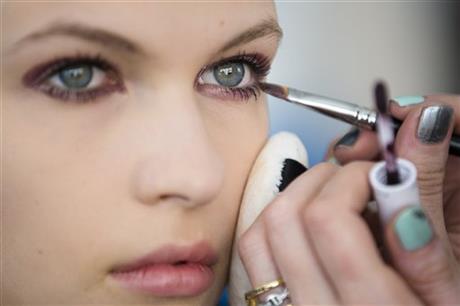The truth about pretty
By Leah Pickett
A model has her makeup applied backstage at New York Fashion Week. AP Photo/John Minchillo
1
/ 2

A model has her makeup applied backstage at New York Fashion Week. AP Photo/John Minchillo
1
/ 2
The truth about pretty
By Leah Pickett
WBEZ brings you fact-based news and information.
Sign up for our newsletters
to stay up to date on the stories that matter.

The beginning of September also marks a new dawn of high fashion trends: another year of being told what’s hot and what’s not. New York Fashion Week is in full swing, and the iconic Vogue “September Issue” with covergirl Jennifer Lawrence is on stands now.
Lawrence may be the most refreshingly real movie star to come along in recent years, but she’s also astoundingly pretty—and pretty sells magazines.
This topic has been on my mind a lot lately, as I recently read a great piece by Bitchtopia‘s Emily Armstrong defining pretty as “a set of skills.” But honestly, pretty is even more than the manipulation of makeup, angles and lighting. Pretty is a lie that the beauty industry has sold us; a promise that no matter how much concealer we buy or miracle products we put in our hair, we will never be good enough. We will always need more.
In 2003, the beauty industry raked in $160 billion worldwide. By 2012, that number had climbed to $426 billion. For even more perspective on the rabid consumerism of all things beauty, consider this: MAC sells one lipstick and one eyeshadow every two seconds, while Sephora alone collects over $636 million in revenue each year.
Countless women claim that they wear makeup purely for themselves; and for many people, this may very well be true. But how often do we wear makeup to impress others, or cover up our supposed flaws? How much time do we spend concealing or tweaking our natural features in order to more closely resemble the models in magazines, or convince the men who say “You look so much prettier without makeup” that our “no makeup” makeup look is real?
The media bombards us with images of beautiful, sun-kissed celebrities every single day, and we long for what they have: Emma Stone’s eyes, Taylor Swift’s nose, Blake Lively’s hair. Addictions form, whether online at Urban Decay or under a plastic surgeon’s knife. The need to be “pretty” becomes insatiable.
Plus, in a world where the vast majority of runway models are white, the lines of otherness are carved even deeper. The ideals of beauty become overwhelming; and for 95 percent of Americans, literally impossible.
But if we have solved one problem (like clearing up our skin or straightening those rebellious curls), the beauty industry will come at us with even more reasons to feel incomplete. Your eyebrows need that perfect arch; you would really look better with this bronzer, these perfectly face-framing sunglasses. The list goes on and on.
I can acknowledge my privilege as a tall, thin, young white woman. I am aware that I fit a certain mold. And yet, I can always find “problem” areas that I need to “fix:” fingernails, teeth, cheekbones, eyelashes. To quote the mirror scene from Mean Girls, “I used to think there was just fat and skinny, but apparently there’s a lot of things that can be wrong with your body.”
How is beauty defined? Some say symmetry, others point to delicate features or clean lines. But in my opinion, true beauty is what emanates from the inside out: kindness, intelligence, generosity, joy. If only these attributes were as easy to come by in our Instagram-obsessed culture, or as marketable as the promise of “pretty.”
Then again, perhaps the rarity of such virtues is what makes the people who posses them so beautiful in the first place. Societal constructs fall away in the presence of what beauty ads boast but rarely deliver, and what money can never buy. When a person radiates happiness from the tips of their fingers (and who cares if they’re manicured or not?), “pretty” can’t even compare.
But for now, I’m just happy that when I enter “pretty” into the search bar on YouTube, this is the second video that appears:
Leah Pickett is a pop culture writer and co-host of WBEZ’s Changing Channels, a podcast about the future of television. Follow Leah on Facebook, Twitter and Tumblr.
